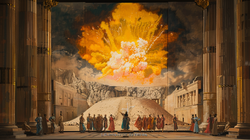L'Auto-immolation du Babkha: Difference between revisions
From MicrasWiki
Jump to navigationJump to search
(Created page with "{{Oportian article}} 300px|thumb|right|"L'Auto-immolation du Babkha" at the [[National Theatre of Oportia; {{AN|1729}}.]] "'''L'Auto-immolation du Babkha'''" is a powerful and thought-provoking fresco adorning the grand foyer of the Théâtre National d'Oportia. Created in {{AN|1735}} by renowned Oportian artist Henri Mansour, the fresco depicts the horrific aftermath of the 1598 Babkhan Holocaust|1598 Babkhan nuclear holoca...") |
No edit summary |
||
| (2 intermediate revisions by one other user not shown) | |||
| Line 1: | Line 1: | ||
{{Oportian article}} | {{Oportian article}} | ||
[[File:MansourL'AutoImmolation.png| | [[File:MansourL'AutoImmolation.png|250px|thumb|right|"L'Auto-immolation du Babkha #1" at the [[National Theatre of Oportia]]; {{AN|1729}}.]] | ||
" | [[File:MansourL'AutoImmolation2.png|250px|thumb|right|"L'Auto-immolation du Babkha #2", showing the Shahanshah and his advisors as a nuclear detonation happens in the background; {{AN|1729}}.]] | ||
"'''L'Auto-immolation du Babkha'''" is a series of two powerful and thought-provoking frescos adorning the grand foyer of the [[Théâtre National d'Oportie]]. Created in {{AN|1728}} by renowned Oportian artist [[Henri Mansour]], the frescos depicts two scenes from the horrific [[1598 Babkhan Holocaust|1598 Babkhan nuclear holocaust]], which devastated the continent of [[Eura]] and forever changed the course of history. | |||
As a central artistic feature in [[Théâtre National d'Oportie|Oportia's national theater]], "L'Auto-immolation du [[Babkha]]" ensures that the painful lessons of the [[Babkha|Babkhan]] nuclear holocaust remain seared into the nation's collective memory and consciousness. | |||
==See also== | ==See also== | ||
*[[Théâtre National d' | *[[Théâtre National d'Oportie]] | ||
*[[Henri Mansour]] | *[[Henri Mansour]] | ||
*[[1598 Babkhan Holocaust]] | *[[1598 Babkhan Holocaust]] | ||
[[Category:Culture of Oportia]] | [[Category:Culture of Oportia]] | ||
[[Category:Art]] | |||
Latest revision as of 23:45, 15 March 2024

"L'Auto-immolation du Babkha #2", showing the Shahanshah and his advisors as a nuclear detonation happens in the background; 1729 AN.
"L'Auto-immolation du Babkha" is a series of two powerful and thought-provoking frescos adorning the grand foyer of the Théâtre National d'Oportie. Created in 1728 AN by renowned Oportian artist Henri Mansour, the frescos depicts two scenes from the horrific 1598 Babkhan nuclear holocaust, which devastated the continent of Eura and forever changed the course of history.
As a central artistic feature in Oportia's national theater, "L'Auto-immolation du Babkha" ensures that the painful lessons of the Babkhan nuclear holocaust remain seared into the nation's collective memory and consciousness.
